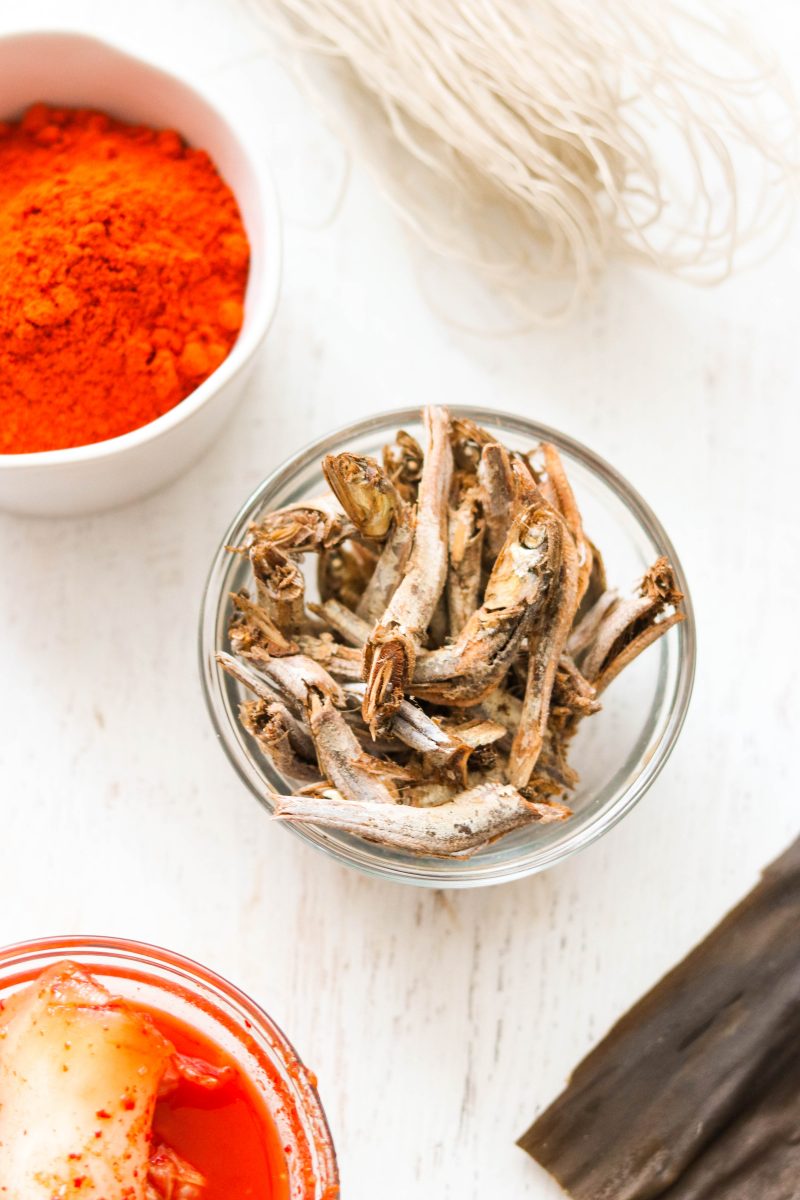This post may contain affiliate links. Please see our disclosure policy.
Find all the essential ingredients for Korean Paleo cooking to make the most delicious and bold flavored dishes in the cookbook, Korean Paleo.

Hi friends! If you’ve been following me on Facebook or Instagram, you’ve probably seen that my very first cookbook, Korean Paleo, is finally published and out in the world! It’s pretty much all I’ve been talking about and I’m so excited to share my favorite recipes I grew up with you guys.
While all the recipes are 100% grain free, gluten free, and made with real food, there are several special ingredients for Korean cooking that give this cuisine its wonderfully bold and umami flavor. You may not be familiar with all the ingredients, and some you may not even have heard of before, so I thought I would go through some of the necessary staple items to stock up on so you can cook from the book with ease.

Before I start, I encourage you to have an open mind when cooking any cuisine that’s new to you. You may feel uncomfortable about handling certain ingredients, but keep in mind that they are what give the wonderful taste to so many traditional dishes and these cooking methods have been passed down from generation to generation!
Avoiding Processed Ingredients in Korean Cooking
Cooking Korean Paleo is slightly different than just Korean. There are some minor substitutions to make so the dishes are grain free and gluten free.
While traditional Korean cooking is quite healthy and anti-inflammatory with various fermentation methods, many sauces and condiments these days are made with wheat flour, corn, high fructose corn syrup, and shady preservatives to cut down on time and cost.
So while the ingredients that I used in Korean Paleo are shortcut-free, they are so much healthier, cleaner, and won’t give you digestive issues if you have food sensitivities!

Essential Ingredients for Korean Paleo Cooking
You can find most of these ingredients if you have an Asian or Korean market near you. But in case you don’t, I am including links to where you can purchase them online! No matter where you are, I love that we all have relatively easy access to so many unique flavors with online shopping.
You can find a detailed list of all the special ingredients on pages 185-187 of the cookbook in the section called “Stocking Up Your Korean Paleo Kitchen.”
Condiments
Apple cider vinegar (or coconut vinegar): Koreans usually use rice vinegar in their cooking, which I give the option to use in the cookbook. Rice vinegar is actually quite harmless, but if you are ultra sensitive to grains, apple cider vinegar is your best grain free substitute that most resembles the slightly sweet taste.
Coconut aminos: If you’ve been cooking paleo for a while, you probably have coconut aminos in the kitchen! It’s an amazing soy sauce substitute that’s made from the sap of the coconut and has a slightly sweeter flavor than soy sauce (used in SO many Korean dishes) without grains or gluten.

Doenjang: This is a Korean version of miso paste. While Japanese miso paste is usually fermented with another grain other than soybeans, a true, authentic doenjang only uses soybeans and salt. The process of making doenjang is quite labor intensive so it’s extremely difficult to find a clean version (the only one I found is this one). Feel free to purchase it if you can consume fermented soy. But if not, I have a 100% grain free version on page 177 of the cookbook that tastes a lot like the real deal!
Fish sauce: High quality, fermented fish sauce is packed with umami and adds such an amazing flavor to so many dishes in the cookbook. The ingredients should just be fish and salt, with no other fillers or sugars. The only brand I recommend that’s high in quality with an amazing taste is Red Boat.

Gochugaru: Since many Korean dishes have some level of spiciness to them, gochugaru, Korean red pepper flakes, are used quite often and this is something you definitely have around if you are making Korean food often. There are two types of gochugaru: coarse flakes and fine powder. You can use coarse flakes in most Korean cooking to add flavor to dishes. The fine powder version is used to make gochujang in the cookbook, spicy and slightly sweet red chili paste that’s also ubiquitous in Korean cooking.
Gochujang: A thick and sticky red chili paste used in marinades, soups and stews, sauces and more, gochujang is made with fine gochugaru, glutinous rice, and some kind of sweetener. This is one of the higher quality ones I’ve seen, but for a truly grain free version that tastes just like the real deal, you can make your own on page 174 of the cookbook.
Saewoojeot: With this one, I really want to emphasize you to keep an open mind. Saewoojeot is basically tiny shrimp that’s been salted and fermented and it adds a ton of flavor to dishes, much like fish sauce. It should have just 2 ingredients: shrimp and salt. I couldn’t find anywhere online where you can order it, but you can easily find clean versions at Asian markets. If you don’t have access to these markets, just substitute saewoojeot with fish sauce in your cooking! This is what it looks like:

Other Special Ingredients for Korean Paleo Cooking
Dried Anchovies: Called myeolchi in Korean, dried anchovies are used in so many different ways in Korean cooking and they come all different sizes as well. The kind you need to cook from Korean Paleo is the large dried ones, which are used to make stock for soups and stews. It adds such a unique depth of flavor, and many soups and stews wouldn’t taste the same without it. While it may look a little freaky if you’ve never handled it before, you actually don’t eat it whole in my recipes, and it’s just simmered in stock for flavoring then discarded afterwards.

Seaweed: There are actually 3 different types of seaweed used Korean Paleo so it can be a bit confusing. Here’s how I label each in the cookbook, and what they are referring to so you can choose the correct kind in the recipes:

Dried kelp (or dashima in Korean and kombu in Japanese): These are thick and flat large sheets of seaweed that come in a big rectangle in various sizes. They are not easily bendable and you have to cut them with kitchen shears to break them up. A large piece of it is used to a delicious and flavorful stock by simmering it in water with spices and dried anchovies. I also have a delicious and crunchy snack called TwiGak (Sweet Fried Kelp Chips) on page 167 of the cookbook!
- Dried seaweed (or mareun miyeok in Korean and wakame in Japanese): This is a different type of seaweed than kelp. While kelp is thick and flat, mareun miyeok is thin and stringy and comes shriveled up. You soak it in water before using it and it’ll expand in size and soften. You then using it to make soups like Miyeok Guk (Seaweed Soup) on page 67 or in side dishes like Miyeok Muchim (Seaweed Salad) on page 122 of the cookbook.
- Dry unseasoned seaweed sheets (or gim in Korean or nori in Japanese): This is probably the type of seaweed you may be the most familiar with. The roasted and flavored versions that are cut into mini rectangles are quite popular these days as seaweed snacks (I have a homemade version on page 129 of the cookbook!), but they can be used for various recipes as seasoning, for Korean sushi (page 15 of the cookbook, and more. You can purchase these online.
Kimchi: Probably the most popular and famous Korean food of all, kimchi is eaten alone or can be used in so many different recipes. Be cautious when you purchase kimchi from a store. Many of them are thickened with rice or wheat flour, and sometimes contain questionable sweeteners like high fructose corn syrup and MSG as well. Your best best is to make it at home using clean ingredients. I have a delicious quick kimchi recipe on page 173 of the cookbook that’s flavorful and packed with probiotics. If you don’t want to make your own, you can try this brand.

Nigari for tofu making: You need these special salt flakes to make just one recipe from my cookbook, paleo Hemp Tofu on page 181. While it’s not necessary if you are not a fan of tofu, tofu is used quite often in Korean cooking and it was one of my proudest moments to be able to make tofu without soy or any grains. Nigari is used to firm and solidify the tofu and this is the cleanest version I found that works really for my recipe. And don’t forget to grab this tofu mold which is the exact one I used to make my paleo tofu!
Grab Your Copy of Korean Paleo!
I hope this list of ingredients for Korean paleo cooking was helpful for you to start cooking from my book! I know you may not be familiar with some of these ingredients, but purchasing them and trying them out in various recipes is the quickest way for you to get over your fear of using them and you’ll be familiarized with them in no time. I think you’ll love all the different and interesting textures and flavors that they impart.

If you have any questions about the ingredients or the cookbook, leave me a comment below! I’m happy to answer any of your questions. And if you end up cooking up from Korean Paleo, please share on social media with the hashtag #KoreanPaleoCookbook!
Grab Your Copy of Korean Paleo!
What Great Grandma Ate / Jean Choi is a participant in the Amazon Services LLC Associates Program, an affiliate advertising program designed to provide a means for sites to earn advertising fees by advertising and linking to Amazon.com.
Regarding other affiliate links and affiliate relationships: In order for me to support my blogging activities, I may receive monetary compensation or other types of remuneration for my endorsement, recommendation, testimonial and/or link to any products or services from this blog. Thank you for your support and understanding.






Aw, yay! So glad you found it helpful, Lindsey. Maybe there be many Korean cooking in your future! 🙂
Hi Jean!
Question, Can you use whole dried anchovies in traditional kimchi ferments or do you need to use fish sauce/paste?
This is a lovely guide BTW, I can’t wait to get cooking with all these ingredients !
-Courtney
Hey Courtney! No – whole dried anchovies is used to make stock or to make side dishes. For kimchi, fish sauce and/or fermented shrimp are used, both of which are explained in this post!